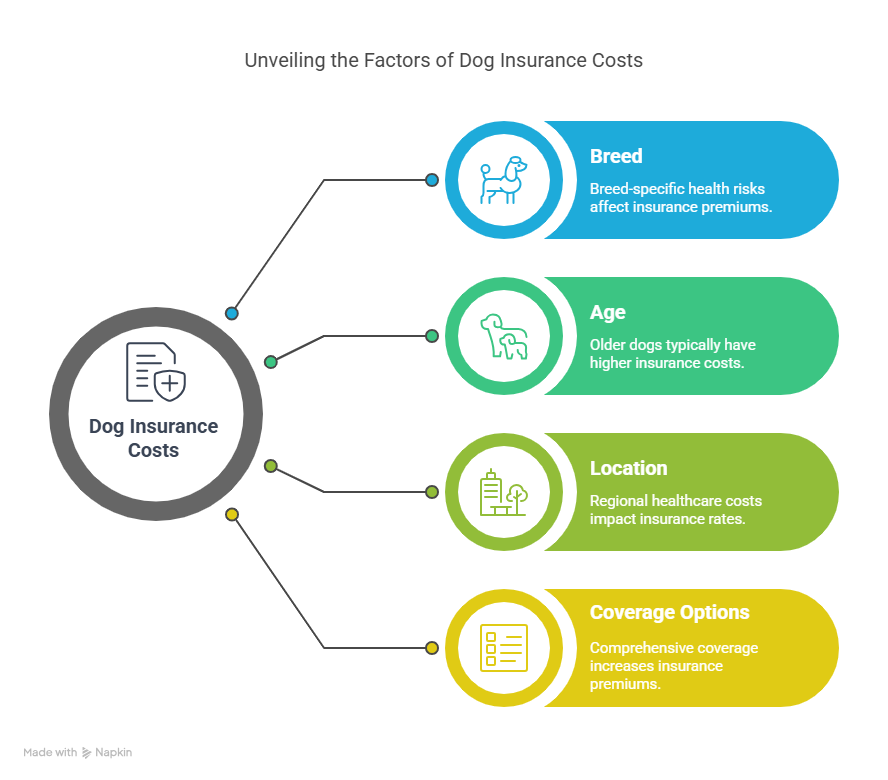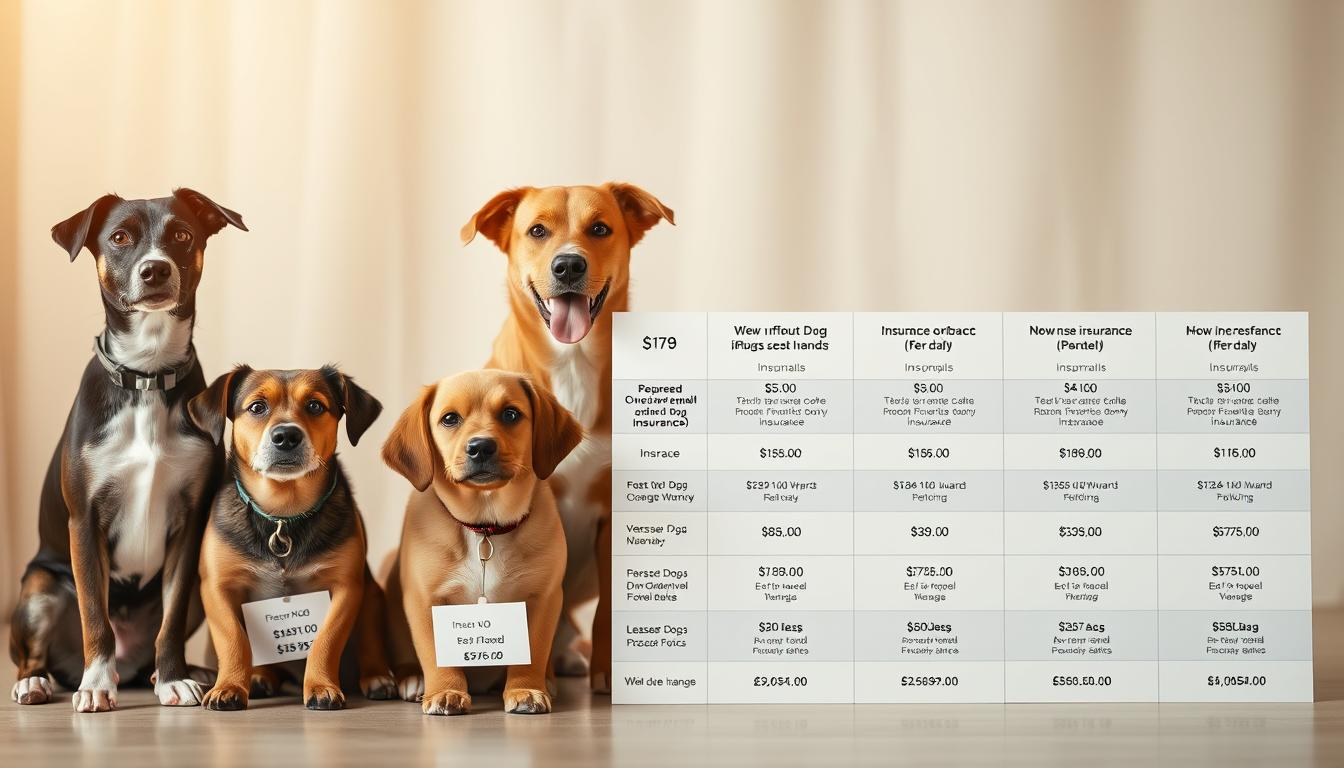You’ve probably felt the happiness of having a pet at your side if you own a dog. But with the growing price of veterinary care, it’s normal to be concerned about having money set aside for unforeseen medical bills. Dog insurance might provide comfort, but it’s important to know how much it will cost.
The age, breed, and health issues of the dog are just a few of the variables that may significantly affect the cost of dog insurance. When selecting an insurance that fits your requirements and budget, it is important to take these aspects into account.
You can make an educated choice and guarantee that your pet gets the treatment they need without going over budget if you are aware of the variables that affect dog insurance rates.
Knowing How Much Dog Pet Insurance Usually Costs
Making educated judgments about your pet’s medical treatment requires knowing the typical cost of dog pet insurance. A number of variables, such as the insurance provider, deductible choices, and coverage type, may affect the price.
Average Monthly Premium Amounts
Basic coverage for dog insurance often costs between $20 and $50 per month, while more extensive policies may cost anywhere from $50 to $100.
The age, breed, and health of the dog are some of the variables that affect the price.
Average Premiums Per Month:
- Basic Protection: $20–$50
- Full Coverage: $50 to $100
The Prices of Various Coverage Types
The cost of pet insurance varies greatly depending on the kind of coverage.
For example, comprehensive coverage that covers wellness and preventative treatment is often more expensive than accident-only coverage.
| Coverage Type | Average Monthly Cost |
|---|---|
| Accident-Only | $10-$30 |
| Basic | $20-$50 |
| Comprehensive | $50-$100 |
Options That Are Deductible and Their Effects
The total cost of pet insurance is mostly determined by deductible selections.
Although monthly premiums are usually cheaper with a larger deductible, you will have to pay more out of pocket for your dog’s medical bills.
For instance, you may reduce your monthly premium by selecting a $500 deductible rather than a $250 deductible; but, you would be responsible for paying the larger deductible amount in the event that you need to make a claim.
Dog owners may choose their pet insurance more wisely if they are aware of these considerations.
Factors That Affect a Dog’s Pet Insurance Premiums
The cost of dog insurance is determined by a number of important criteria. You can make wise judgments about your dog’s coverage and navigate the complicated world of pet insurance by being aware of these factors.

Breed-Specific Price Variations
Your dog’s breed has a big impact on how much insurance will cost. Premiums may go up for some breeds since they are more likely to have certain health problems. For example, insurance premiums for breeds with respiratory issues, such as Bulldogs and Pugs, may be higher than those for Greyhounds or Whippets.Breeds having a history of expensive medical issues are often subject to increased insurance rates from insurance providers.
Effects of Age and Health Status
The age and health of a dog are also important considerations when calculating insurance premiums. Because they are less likely to have pre-existing medical issues, younger dogs often have lower insurance costs than older dogs. Premiums rise as your dog gets older since health problems are more likely to occur. Dogs with pre-existing conditions may also be subject to exclusions from some insurance or higher charges.
Cost Variations by Location in the United States
The cost of your dog insurance might be greatly impacted by where you reside in the US. State laws and regional variations in veterinary care costs may have an impact on rates. For instance, because of the greater expense of living and veterinary treatment in metropolitan places like New York or San Francisco, premiums may be higher than in rural regions.
How Premiums Are Determined by Insurance Companies
Dog insurance rates are determined by a number of parameters used by insurance providers. These include your location, the dog’s age, breed, and health, in addition to the coverage level you choose.Insurers evaluate the risk of insuring your dog using actuarial calculations and statistical data, which influences your rate. You may more easily browse the pet insurance market and choose a plan that meets your requirements and price range by being aware of these characteristics.
Locating Reasonably Priced Dog Insurance Choices
Finding reasonably priced dog insurance demands more than simply comparing rates; it also entails being aware of the several aspects that affect pricing. As a pet owner, you want an insurance that provides complete coverage at a fair cost, not simply the lowest one.
Comparing Various Insurance Companies
Researching and contrasting various insurance companies is crucial when comparing dog insurance rates. Different coverage levels, deductibles, and premiums may be offered by different companies. Finding an insurer that meets your dog’s requirements is essential since some specialize on certain breeds or medical issues.
To help you decide, compile a list of possible insurers and evaluate their:
- Premiums each month
- Limitations of coverage
- Options that are deductible
- Limitations and exclusions

Available Discounts and Savings Opportunities
Numerous pet insurance providers provide savings options and discounts that may drastically lower your costs. These might consist of:
- discounts for many pets when purchasing pet insurance
- Discounts for yearly payments for upfront premium payments
- Military or student discounts
- incentives for new clients
When receiving an estimate, always ask about any reductions that could be offered.
Advice for Selecting the Best Budget-Friendly Plan
Choosing the right dog insurance plan involves balancing your budget with the level of coverage your pet needs. Here are some tips for selecting an affordable dog insurance plan:
The quantity of coverage your pet requires and your budget must be balanced while selecting the best dog insurance plan. The following advice will help you choose a reasonably priced dog insurance plan:
- Examine your financial status and your dog’s medical requirements.
- To reduce your rates, think about raising the deductible, but be sure you can afford it.
- Instead of choosing an insurance with an annual restriction, choose one with a lifetime limit or per-condition limit.
- Every year, review and modify your policy to make sure it still meets your dog’s evolving requirements.
You may get reasonably priced dog insurance that protects your pet without breaking the bank by carefully evaluating companies, looking into discounts, and choosing a plan that suits your needs.
Conclusion
There are a lot of elements to consider when calculating the cost of pet insurance for a dog. Breed, age, health, and location are some of the variables that affect the typical cost of dog pet insurance.
Monthly charges for dog insurance might vary greatly, according to a list of expenses. Dog owners may make well-informed choices about their pet insurance by being aware of the various coverage kinds, deductible alternatives, and cost variations depending on breed and age.
Comparing several insurance companies, looking into any discounts, and selecting a plan that suits your spending limit are all crucial steps in finding reasonably priced dog insurance. By doing this, you can make sure your dog gets the care they need without going over budget.
FAQ
How much does pet insurance cost for a dog on average?
The average cost of pet insurance for dogs can range from $20 to $50 per month, depending on factors such as the dog’s age, breed, and health status, as well as the coverage type and deductible chosen.
What factors influence the cost of dog insurance?
Several factors can influence the cost of dog insurance, including the dog’s breed, age, and health status, the location within the United States, and the type of coverage and deductible selected. Insurance companies also consider these factors when calculating premiums.
Are there any discounts available for dog insurance?
Yes, some insurance providers offer discounts for dog insurance, such as multi-pet discounts, discounts for certain breeds or age groups, or promotional discounts for new customers. It’s essential to compare different insurance providers to find available discounts and savings opportunities.
How can I find affordable dog insurance?
To find affordable dog insurance, compare different insurance providers, consider various coverage types and deductible options, and look for available discounts. Choosing a plan that fits your budget requires evaluating your dog’s needs and your financial situation.
What is the difference between accident-only and comprehensive dog insurance coverage?
Accident-only coverage typically costs less but only covers veterinary expenses related to accidents, whereas comprehensive coverage includes both accidents and illnesses, providing more extensive protection but at a higher premium.
Can I customize my dog insurance plan to fit my budget?
Yes, many insurance providers allow you to customize your dog insurance plan by choosing from different coverage types, deductible options, and reimbursement levels, helping you find a plan that suits your budget and your dog’s needs.
How does my location affect dog insurance costs?
Location can impact dog insurance costs due to regional differences in veterinary care costs, the prevalence of certain health issues, and state regulations. Insurance companies consider these factors when determining premiums for different areas within the United States.
Are there any additional costs associated with dog insurance besides the monthly premium?
Besides the monthly premium, you may need to pay deductibles, copays, or coinsurance, depending on the insurance plan. Understanding these additional costs is crucial to calculating the total cost of dog insurance.




